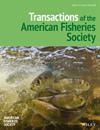水电设施中顺流而下的美洲鳗鱼的环境线索
IF 1.4
3区 农林科学
Q2 FISHERIES
引用次数: 0
摘要
研究旨在确定影响罗阿诺克急流湖(罗阿诺克急流大坝和电站形成的罗阿诺克河上的一个水库)中美洲鳗鲡(Anguilla rostrata)下游洄游和通过的环境因素。方法在2019年10月至2023年3月的四个外迁期间,在电站下游的罗阿诺克急流湖和罗阿诺克河上安装了黄相和银相美洲鳗鲡声学发射器,并使用声学遥测接收器对其进行监测。利用声学探测数据确定下游通过电站的时间。结果 美国鳗鱼从罗诺克急流湖迁出的概率受一天中的时间、降雨量和水电运行导致的湖面变化的影响。洄游概率的预测模型表明,在不同的环境条件下,美洲鳗的洄游数量变化很大,而且对湖泊水位的变化特别敏感。结论这项研究的结果表明,管理措施,如大坝的计划放水和随之而来的湖泊水位变化(或相关因素),会影响美洲鳗洄游的开始和时间。本文章由计算机程序翻译,如有差异,请以英文原文为准。
Environmental cues for downstream‐migrating American Eel at a hydroelectric facility
ObjectiveThe purpose of study was to identify environmental factors that influence downstream migration and passage of American Eels Anguilla rostrata in Roanoke Rapids Lake, a reservoir on the Roanoke River formed by the Roanoke Rapids Dam and Power Station.MethodsYellow‐ and silver‐phase American Eels were outfitted with acoustic transmitters and monitored during four out‐migration periods from October 2019 through March 2023 using acoustic telemetry receivers placed in Roanoke Rapids Lake and the Roanoke River downstream of the power station. The timing of downstream passage through the power station was determined using acoustic detection data. Poisson regression models were used to analyze American Eel detections in the context of environmental variables that were hypothesized to cue out‐migration.ResultOut‐migration probability of American Eels from Roanoke Rapids Lake was influenced by time of day, rainfall, and change in lake level attributable to hydropower operations. Predictive models of out‐migration probability demonstrated that the number of migrating American Eels was widely variable across environmental conditions and was particularly sensitive to changes in lake level.ConclusionThe results of this study suggest that management actions, such as scheduled water releases from a dam and the consequent change in lake level (or correlated factors), can influence the onset and timing of American Eel out‐migration.
求助全文
通过发布文献求助,成功后即可免费获取论文全文。
去求助
来源期刊
CiteScore
2.90
自引率
7.10%
发文量
48
审稿时长
8-16 weeks
期刊介绍:
Transactions of the American Fisheries Society is a highly regarded international journal of fisheries science that has been published continuously since 1872. It features results of basic and applied research in genetics, physiology, biology, ecology, population dynamics, economics, health, culture, and other topics germane to marine and freshwater finfish and shellfish and their respective fisheries and environments.

 求助内容:
求助内容: 应助结果提醒方式:
应助结果提醒方式:


